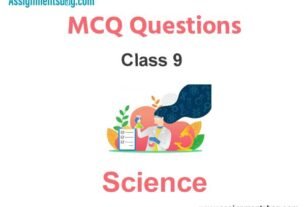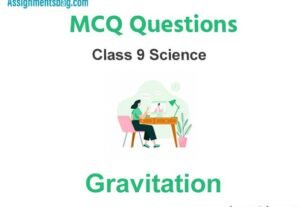Please refer to MCQ Questions Chapter 14 Natural Resources Class 9 Science with answers provided below. These multiple-choice questions have been developed based on the latest NCERT book for Class 9 Science issued for the current academic year. We have provided MCQ Questions for Class 9 Science for all chapters on our website. Students should learn the objective based questions for Chapter 14 Natural Resources in Class 9 Science provided below to get more marks in exams.
Chapter 14 Natural Resources MCQ Questions
Please refer to the following Chapter 14 Natural Resources MCQ Questions Class 9 Science with solutions for all important topics in the chapter.
MCQ Questions Answers for Chapter 14 Natural Resources Class 9 Science
Question. In which part of leguminous plants are nitrogen-fixing bacteria found?
(a) Root nodules
(b) Leaves
(c) Stems
(d) Flowers
Answer
A
Question. How is ozone formed?
(a) Three carbon atoms combine to form ozone.
(b) Three oxygen atoms combine to form ozone.
(c) One carbon atom and two oxygen atoms split to form ozone.
(d) One oxygen atom and two hydrogen atoms split to form ozone.
Answer
B
Question. Which of the following does not lead to water pollution?
(a) The addition of undesirable substances to water- bodies.
(b) The removal of desirable substances from water- bodies.
(c) A change in pressure of the water bodies.
(d) A change in temperature of the water bodies.
Answer
C
Question. The main reason of pollution in river A could be due to accumulation of
(a) phosphates of detergents in the river
(b) hot water released from industries
(c) mercury salts in the river
(d) pathogenic micro organisms in the river
Answer
A
Question. Rainfall patterns across a particular area mainly depends on
1. the prevailing wind patterns.
2. the pattern of population density in the area.
3. the amount of available groundwater in the area.
(a) 1 and 3
(b) 1 and 2
(c) 2 and 3
(d) Only 1
Answer
D
Question. Topsoil contains
(a) living organisms only
(b) humus and soil particles only
(c) dead organisms and living plants
(d) humus, living organisms and soil particles.
Answer
D
Question. Why is ozone layer important?
(a) It is used by living organisms for respiration.
(b) It increases the temperature of the earth.
(c) It reduces the amount of ultraviolet rays reaching the earth.
(d) It reflects the heat from the earth back into the atmosphere.
Answer
C
Question. Regularly breathing air that contains unburnt carbon particles causes health problems such as
(a) asthma
(b) allergies
(c) cancer
(d) all of these
Answer
D
Question. Materials of biological origin which are commonly used to maintain and improve soil fertility are
(a) green manure
(b) biofertilizers
(c) bioinsecticides
(d) both a and b
Answer
D
Question. Find a poisonous pollutant from the following.
(a) SO2
(b) CO
(c) CO2
(d) NH3
Answer
B
Question. Acid rain can be best defined as
1. surface run-off from agricultural land containing chemicals like fertilizers.
2. rain water containing dissolved acids.
3. the rain of acids formed in the clouds due to lighting.
(a) 1 and 2
(b) 1 and 3
(c) Only 2
(d) Only 1
Answer
C
Question. What do you mean by ‘environment’ ?
(a) Lithosphere
(b) Biosphere
(c) Hydrosphere
(d) Atmosphere
Answer
B
Question. Which one of the following is an inexhaustible resource?
(a) Fossil fuels
(b) Minerals
(c) Soil
(d) Solar radiation
Answer
D
Question. Identify the gas that can result in the formation of acid rain.
(a) Ozone
(b) Carbon monoxide
(c) Sulphur dioxide
(d) Chlorofluorocarbon
Answer
C
Question. Ecosystem comprises both abiotic and biotic components. Biotic component of an ecosystem consist of
(a) producers
(b) consumers
(c) decomposers
(d) all of these
Answer
D
Question. What happens if a person is exposed too much to ultraviolet rays?
(a) It affects weather.
(b) It causes rickets.
(c) It causes cancer.
(d) It is a rich source of vitamin D.
Answer
C
Question. Select the term that means ‘cycling of elements in an ecosystem’.
(a) Chemical cycle
(b) Geochemical cycle
(c) Bio-geochemical cycle
(d) Geological cycle
Answer
C
Question. Which of the following is a major cause of air pollution? (a) Burning of wood
(b) Burning of biogas
(c) Burning of cow dung cakes
(d) Burning of fossil fuels
Answer
D
Question. In which zone of atmosphere does the cloud formation take place?
(a) Troposphere
(b) Stratosphere
(c) Thermosphere
(d) Ozonesphere
Answer
A
Question. Select the correct statement(s) regarding water harvesting.
1. It is the process of collecting water from tube wells.
2. It is the process of collection of river water for irrigation.
3. It is the technique of collection of rainwater for use during irrigation.
4. It is the collection of rainwater in the soil to recharge ground water.
(a) 1, 3 and 4
(b) Only 1
(c) 3 and 4
(d) 1, 2, 3 and 4
Answer
C
FILL IN THE BLANK :
Question. Carbon present in the abiotic environment is fixed by the plants in the form of atmospheric CO2 and dissolved CO2 in water through a photochemical process known as ……….
Answer
Photosynthesis
Question. Glaciers are a sources of ……….
Answer
Water
Question. Pattern of the rainfall depends on the pattern of ……….
Answer
Wind
Question. Forests and wildlife are examples of ………. renewable
Answer
Living
Question. Nitrogen fixation is conversion of ………. nitrogen into nitrates.
Answer
Atmospheric
TRUE/FALSE :
Question. Pollution of air, water and soil affect the quality of life and harm the biodiversity.
Answer
True
Question. Ozonosphere is located in troposphere of atmosphere.
Answer
False
Question. 75% of Earth’s surface is covered with water.
Answer
True
Question. Air forms a protective blanket around the earth and does not allow all the solar radiations to reach the Earth.
Answer
False
Question. Topsoil is the uppermost fertile layer of soil that is rich in mineral nutrients.
Answer
True
MATCHING QUESTIONS :
Question.

Answer
C
Question.

Answer
C
Question.


Answer
B
ASSERTION AND REASON :
DIRECTION : In each of the following questions, a statement of Assertion is given and a corresponding statement of Reason is given just below it. Of the statements, given below, mark the correct answer as:
(a) Both assertion and reason are true and reason is the correct explanation of assertion.
(b) Both assertion and reason are true but reason is not the correct explanation of assertion.
(c) Assertion is true but reason is false.
(d) Both Assertion and Reason are false.
Question. Assertion : Evaporation and transpiration maintain the water level on the Earth.
Reason : Evaporation is loss of water from water bodies whereas transpiration is absorption of water from roots of a plant.
Answer
C
Question. Assertion : Nodules are found only in the roots of leguminous plants.
Reason : Rhizobium is a symbiotic bacteria that live in the roots of legumes.
Answer
B
Question. Assertion : Oxygen cannot get eliminated from the atmosphere.
Reason : Oxygen is a most abundant element on our Earth.
Answer
C
Question. Assertion : Substances are transported from one part of the body to the other in a dissolved form.
Reason : Water is a good solvent.
Answer
B
Question. Assertion : Extensive use of CFCs increases the chances of skin cancer.
Reason : CFCs deplete the ozone layer in stratosphere.
Answer
A

